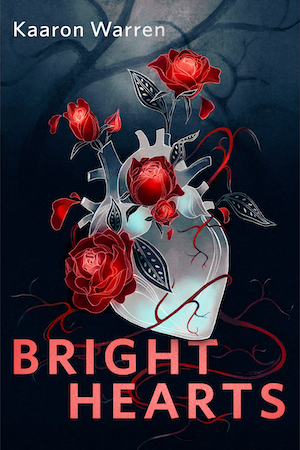The landscape of ‘90s teen horror was dominated by novels. Whether standalone stories or as part of a larger series (like R.L. Stine’s Fear Street), these short books flooded the market, defining the genre and keeping bookstore shelves well-stocked with new scares. Aside from the edited collection Thirteen—which featured stories from some of teen horror’s heaviest hitters, including Stine, Christopher Pike, Caroline B. Cooney, Sinclair Smith, and others—there wasn’t much short fiction to be had. While I had vivid recollections of Thirteen from my own teen horror days, I had no memory at all of Christopher Pike’s Tales of Terror (1997) and Tales of Terror 2 (1998).
Pike’s two short fiction collections were published in the waning days of the ‘90s teen horror trend, which started running out of steam around 1996, and this may be part of why it flew under my radar. But reading these stories now, there are some real gems in the two Tales of Terror collections, both in terms of typifying ‘90s teen horror trends and in engaging with the narratives and themes explored in Pike’s novels. There’s a lot to tackle here, so we’ll explore Pike’s Tales of Terror collections over the course of a couple of columns, with dark revenge stories in this one and the more esoteric and entertaining tales in the next column.
Both collections feature stories that are interconnected with Pike’s book Master of Murder (1992), with “The Fan From Hell” in Tales of Terror and “The Burning Witch” in Tales of Terror 2 focusing on the further adventures of Marvin Summer, his cushy lifestyle as a best-selling horror writer, and (unsettlingly) his exploitation of and violence against young women who come into his orbit. These stories further develop Master of Murder’s perspective of Marvin’s girlfriend Shelly as a deadly femme fatale, with “The Fan From Hell” noting that Marvin “still believed that Shelly had killed a mutual acquaintance, Triad, about the time they had started going out … she had never admitted to doing the black deed and maybe that was why he still found her so endlessly fascinating, the mystery of not knowing” (39). Marvin and Shelly’s relationship is complicated: he lives in a townhome on the California coast, while Shelly has gone across the country to go to college—and while he claims to love only her, Marvin does acknowledge that “he was faithful to Shelly only within specifically defined geographical circumstances” (45). He cheats on her repeatedly—almost always with young women who reach out to him to tell him what a genius he is—but is filled with rage when he thinks of Shelly doing the same. She takes a heavy load of summer classes each year so that she can graduate early and move back to the West coast to be with Marvin, though he’s not all that thrilled when she shows up and makes almost no changes to his life or home to accommodate sharing those with her.
In “The Burning Witch,” when Shelly is devastated after learning that she cannot have children, it turns out Marvin never really thought about them having a family together and can’t figure out what she’s so upset about, telling her he’s pretty relieved not to have to worry about accidental pregnancy and that “you can always adopt later, if you want” (5). Marvin seems pretty intentional in his choice of “you” rather than “we,” apparently still seeing their lives as separate, regardless of the years that they have spent together. Later though, when Shelly is murdered by witches who want to have sex with Marvin, he is willing to sacrifice whatever he has to to get her back, though there really aren’t any indicators that he has a new appreciation for her or that he will be any more committed to Shelly or a future together than he has been in the past. It’s almost like she’s a coveted prize that he has won—she was his dream girl in high school and remained well out of his reach until her alleged murder of Triad brought them together—and now that he has her, there’s no way he’s letting her go, even if he doesn’t actually want her anymore.
“The Fan from Hell” and “The Burning Witch” are the only two stories in Pike’s Tales of Terror collections that explicitly connect with and build upon narratives and characters established in his novels, though he does note some resonance in themes between other stories and his books, including similarities between “Death of Despair” and his Remember Me trilogy (1989-1995). One of the strongest themes in these stories that draw upon and connect with Pike’s larger body of work is that of (usually sex-fueled) teenage revenge.
Pike navigates revenge narratives through different directions, including realism, fantasy, and the murky gray areas in between in Tales of Terror’s “Death of Despair” and “Revenge,” and in Tales of Terror 2’s “The Tears of Teresa.” As Pike mentions in his author note that prefaces “Death of Despair,” there are some similarities between this story and Remember Me, namely in a suicide from a high-rise balcony that isn’t quite what it seems. While readers eventually learn that Remember Me’s Shari Cooper was actually murdered, in “Death of Despair,” Mike Cutter wakes up in his parents’ townhouse following a wild party and encounters three identically dressed and beautiful young women: his ex-girlfriend Penny, his girlfriend Linda, and Sandy, a girl he had recently rejected. According to these young women, Mike is already dead, having jumped from the balcony in a fit of despair the night before when Linda broke up with him. His vision is clouded, everything is darkly shadowed, and they take him out onto the balcony to show him his body in the bushes far below. The only way to move on to the afterlife, they say, is for him to jump now from the balcony so his spirit can rejoin his body. But the problem is that Mike isn’t actually dead … yet.
Linda is really upset because Sandy told her that Mike had been unfaithful (which he denies) and Penny’s still heartbroken that Mike dumped her to be with Linda, while Linda’s upset that when Mike broke up Penny, he kissed her goodbye. So obviously the only way to balance the scales is to trick Mike into jumping from the balcony and committing suicide. That’ll teach him. There’s a good deal of confusion over Mike’s fidelity (or lack thereof). For example, when Mike denies ever having had sex with Sandy, she tells Linda that “There is sex in a technical sense and there in sex in a backseat-of-the-car sense. We had the backseat and then he begged me for the technical details” (23-24) and I’ve honestly got no idea what that means. Did they? Didn’t they? Is Sandy arguing that sex is a matter of interpretation? It’s all relatively baffling, but these young women have gone to great lengths to convince Mike that he’s really dead, including dyeing his contact lenses to mess with his vision, drugging him, and buying an inflatable doll and making fake blood in order to convince him that he’s actually looking at his own dead body several stories below. But Mike turns the tables, shoves all three of them to their deaths from the balcony, and scores a free blow-up doll, which he gives a bubble bath to clean off both the fake blood and the girls’ real blood, and then snuggles up with to go to sleep, in a bizarre and darkly humorous conclusion.
The revenge plots in “Revenge” and “The Tears of Teresa” are less convoluted, with both centering around a wronged man seeking to punish the woman who betrayed him, with the women’s names inspired by a not-so-fondly remembered ex-girlfriend of Pike’s. In the author note to “Revenge,” Pike reflects that “I used to have the bad habit of putting the young woman I happened to be dating into the book I was working on. How we were getting along often determined how her character fared—whether she died slowly and painfully or quickly and with dignity” (157), which is honestly a little disturbing. Anyway, he and Teresa went swimming one day in rough seas when Teresa sank down beneath the water and didn’t resurface. After remembering his fear for her safety, he writes that “She was under for probably only ten seconds—I reached her quickly. Even though I saved her life, she was none too happy with me when we were back on shore. She wouldn’t even talk to me—it was distressing” (158). He doesn’t seem to realize that Teresa was probably plenty distressed herself by nearly drowning, but instead watches the boats come and go and dreams up the plot for “Revenge.”
In “Revenge,” the narrator Chris is really upset, first that his girlfriend Teresa won’t have sex with him, and second, after she finds someone else, is unfaithful to Chris, and starts a new relationship with Mr. Wonderful–she decides sex isn’t too bad after all. All that sex that he isn’t having drives Chris mad and he decides the best course of action is to don his scuba gear, lurk underwater at a beach where Teresa and her new fella like to swim, and then pull her under the water to the bottom and hold her there until she drowns. There are some unexpected challenges, but everything seems to go pretty much according to plan (though the new boyfriend tries to come to Teresa’s rescue and gets murdered too, which is fine with Chris), until Chris gets home and finds out that Teresa has survived. He rushes to her side, is welcomed by her family with open arms, and when he talks to her, instead of being identified as a murderer, she tells him she was wrong to break up with him, that she loves him, and that when she thought she was going to die “all I could think about was you … You felt so close to me, so close to my soul, and I suddenly knew that it was you I loved” (179). This is incredibly unsettling, particularly because Chris’s feelings toward Teresa are still an uneasy mixture of love, obsession, and toxic hatred, so who knows what their relationship dynamic is going to look like moving forward. After Teresa’s recovery, Chris takes a sick pleasure from putting his arm over her throat to see if her body will remember him as the one who choked her (the answer seems to be kind of), which definitely isn’t a healthy relationship indicator. Chris does make sure to tell readers in the story’s final section that he and Teresa finally had sex, so there’s a load off of our minds, I guess.
“The Tears of Teresa” is much less morally complex and adds a kind of metaphysical twist, with a married couple who are kidnapped at knifepoint and paralyzed, as Pike weaves together two intersecting stories of past betrayal and present retribution. More than eighteen years ago, Teresa told her boyfriend Max that she was traumatized because he forced her to have an abortion. Max’s family has a lot of money and while Max is terrified of his father’s disapproval, Teresa convinces Max to marry her on a whirlwind trip to Las Vegas, colludes with Max’s best friend (and her secret lover) David, and pushes Max off the hotel balcony, before we discover that she is actually still pregnant and plans to have the baby in order to blackmail Max’s grieving father. Max survives long enough to be taken to the hospital and dies next to a crying baby, and this baby then grows up to become the mysterious and avenging stranger who kidnaps Teresa and David from their disappointingly bland suburban life (the blackmail didn’t work) almost two decades later to make them pay for their transgressions.
While many of these revenge plots are outlandish, sometimes these tales of revenge take a serious turn. This is the case with the school shooting story of “The Thin Line,” which feels a bit too familiar and depressingly timely. Tim Klane was a starter on the basketball team and dating the head cheerleader, Jane Pascal, “who just happened to be the coach’s daughter” (134). Coach doesn’t like Tim seeing his little girl and Tim takes a hit in practice that he thinks was intentional (though the other player later denies this). Regardless of intent, however, Tim suffers a serious back injury which ends his basketball career and ends up in constant, severe pain. Jane refuses to see him anymore, he’s lost his basketball dreams forever, and he’s become addicted to strong painkillers. In this haze of depression and suffering, he decides he needs to make everyone pay. He buys two guns, locks the doors to the gym, and prepares to take out the coach, the basketball team, and the cheerleading squad. Tim actually shoots just one person: Steve Wiley, who took over Tim’s position as center, is Jane’s ex-boyfriend, and is the guy Tim thinks took him out at practice, making him responsible (as far as Tim sees it anyway) for all Tim’s pain. Tim is immediately horrified by what he has done, recalling that “The bullet caught him in the mid right thigh and, oh God, what a mess. No shot ever fired on TV got results like this. He didn’t develop a nice round red hole that could be covered with a white bandage. The middle of his leg literally exploded. Muscle and bone and blood erupted like a living volcano, splattering me as well as him. I actually tasted his blood on my lips” (154-155). This description is explicit and gruesome, foregrounding the consequences of Tim’s actions, the dissonance between his fantasy of revenge and the devastating reality. This is (thankfully) the only shot Tim fires, instead relying on the threat of violence from this point forward, and he finds out later that while Steve lost his leg, he lived. What follows becomes more of a hostage situation story as Tim takes Jane and goes on the run, though things don’t end well for them and Tim is haunted by the mistakes he has made.
While it is challenging for me to wrap my head around how this story might have read at the time of its publication before Columbine and the epidemic of school shootings that have defined the last two and a half decades, Pike does foreground real-life inspirations and influences on the story. As he writes in his author’s note, “I never wrote a story about which I had such reservations … I started ‘The Thin Line’ before the killings in Jonesboro, Arkansas, and did not finish it until after Springfield, Oregon. It was weird for me to watch what I was writing appear on the news” (132). (Both of these shootings occurred in 1998. The shooters at Westside Middle School in Arkansas killed four fellow students and a teacher; the shooter at Thurston High School in Oregon killed two fellow students and wounded more than two dozen others). Reading Pike’s story and thinking about that specific context, as well as how the conversation surrounding school shootings has (and hasn’t) evolved in the intervening decades is disorienting and depressing. There’s no way to really dismiss or neutralize the horrors of “The Thin Line,” whose very title reminds us of how close so many of us are to this potential violence every single day.
While Pike’s short stories might lack some of the narrative development and evolving themes of his books, his philosophical perspective and approach to horror still resonate in these tales. As with so much of ‘90s teen horror, Pike’s books at times get convoluted, with ridiculous red herrings and sensationalistic side plots, but there’s little room for those kinds of departures in these stories. There’s no extraneous fluff. Pike gives us interesting (if not fully developed) characters, puts them in weird situations, and lets the action play out as it will, often with sexy, disastrous, or violent consequences. These two short fiction collections may be among the least well-known of Pike’s teen horror books, but they contain some darkly entertaining tales, more of which we’ll dig into next time!










